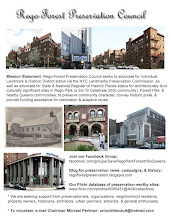 |
| Forest Hills Gardens town crier |
 |
| The ceremony on Village Green now Flagpole Green |
Children were ready to play games in Station Square at 10 AM, thanks to the direction of Dr. W. F. Seybolt.. The publication read, “There are between fifty and sixty very happy boys and girls who are wearing bronze and silver badges, won at the children’s games in canvas-covered Station Square between 10 and 12 o’clock.” It continued, “With kiddie car races, pillow fights, sack and relay races, a whole program of fun, speed, and skill was carried out.” The lineup also included games for adults such as a baby carriage race, football kicking and ball tossing, tilting matches, tug-of-war between easterners and westerners.
 |
By 4 PM, attendees were in tune for opera at Olivia Park, a natural amphitheatre. Milton Aborn directed a company which performed “Pagliacci” by Ruggero Leoncavallo (1892) and “Cavalleria Rusticana” by Pietro Mascagni (1889). The Metropolitan chorus featured 24 vocalists and the Metropolitan orchestra featured 17 members. Scenery was minimal to maximize on the park’s charming ambiance.
Between 5 and 7 PM, festivities included a home-cooked supper by the Women’s Guild of the Church-in-the-Gardens social room for $1, where the proceeds would benefit the Community House fund.
At 7:30 PM, they made their way back to Station Square for a band concert and the community Choral Club that performed several patriotic airs comprised of nearly 75 vocalists. Another highlight was music at twilight by the Regiment Band of the 22nd Corps of Engineers, a 40-piece band under Master George Briegel. The evening continued with dancing in Station Square at 9 PM, lasting until midnight. The Forest Hills Gardens Bulletin read, “The dance on Station Square, lighted by myriads of red, white, and blue incandescents, will fittingly close a happy family and community patriotic day – the Independence Day of 1920, long to be remembered”… “The decorations will consist of myriads of American flags interspersed with those of the Allies, all placed to produce the best effect.” It also stated, “All the lads and lassies, maids and matrons and escorts danced on the canvas covering until – well, why tell the hour – for the music was the best and the night balmy.” Over 3,000 people were in the audience and among the dancers, and Chairman Henry W. Hirschberg was commended for this final feature.
The festival offered a humanitarian aspect. Proceeds from the refreshment booth, which served ice cream cones, lemonade, iced tea, sandwiches, and cake, benefited the Big Sisters of Queens Borough. Based on the prior year’s partnership, the Big Sisters received over $200 and assisted seven children who would have traditionally ended up in institutions, and ultimately helped them find suitable homes.
Reflecting on the festival’s success, the publication stated, “Our friends and relatives were here in such numbers that it was apparent that our village is growing, and that everyone likes ‘our party,’ as Dr. Sweeny, the chairman, called it.” It continued, “The most impressive and appropriate part of the program, in the humble opinion of the editor, was in the Flag raising and the singing of the newly christened Choral Club.”
A similar version was featured in Michael Perlman's Forest Hills Times column: http://foresthillstimes.com/view/full_story/27760129/article-1920s-patriotism--Forest-Hills-style
A similar version was featured in Michael Perlman's Forest Hills Times column: http://foresthillstimes.com/view/full_story/27760129/article-1920s-patriotism--Forest-Hills-style






